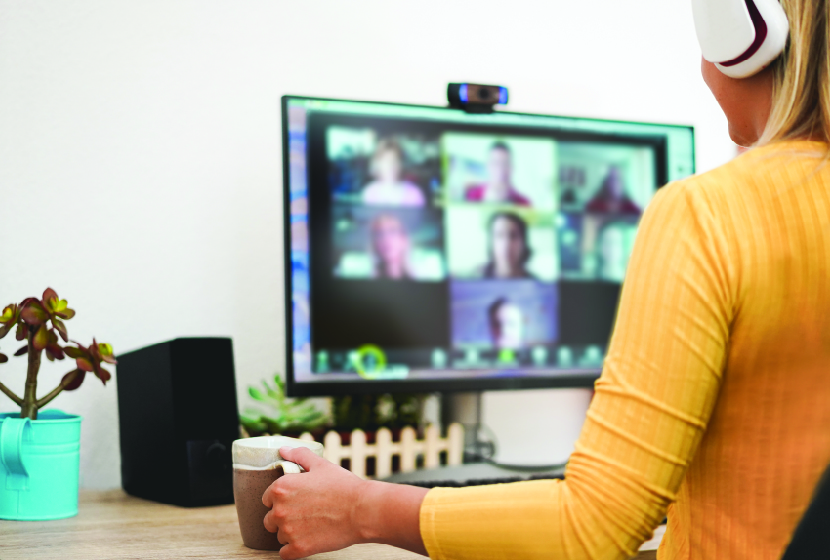 What Is Hybrid Training?
What Is Hybrid Training?
Hybrid training happens when a facilitator provides a learning experience to any combination of two or more of the following groups simultaneously:
- A group of people with the facilitator in a training room
- Many individuals at home or alone in their office in front of their computers with possibly just one screen
- A group gathered around a board room table or in a conference room, some with and some without their laptops, and who may or may not have access to a videoconferencing system or large-screen monitor with speakers
Considerations For Hybrid Training Sessions
Here are some things to consider as you structure and invite people to your hybrid sessions.
Topic
It is best to decide if the objective and outcomes will be best met by training. Have discussions ahead of time with key stakeholders to determine if this will be the most effective way for a particular audience to learn and grow in the chosen content. The truth is, some things are simply best taught in person, through coaches and mentors or by sending a facilitator to teach on location.
Technology
Which platform will you be using? Will everyone have the necessary bandwidth and signal strength to participate without audio and connectivity issues? Will you provide a short video tutorial in advance, so they know how to use the features of the platform? Or will you allocate time for this at the start of the session? Don’t overlook the importance of this step because impediments to participation inevitably result in frustration and lasting negative impressions of training. Be sure to test your technology at least 30 minutes before the session start.
Design
Traditionally trainers have focused on providing as much content as possible in the allotted time. However, we’ve seen evidence that adults learn best in bite-sized pieces with opportunities to discuss and practice concepts learned, and we might believe that less is more. Use a 30-40-30 guide for time allotment: 30% for “trainer time” (set context, provide guidelines, teach content, explain activities), 40% for group interaction (partner, small-group and large-group interaction, role-play, discussion) and 30% for participant reflection and planning (outlines, assessments, action plans). This gives lots of room in the schedule for workarounds and “Plan Bs” if there are technical mishaps or other issues.
Activities
Plan activities that everyone can participate in, whether in your classroom, with a small group or alone. You can use your platform’s breakout rooms if everyone has access to their laptop and a Teams or Zoom link. Allow time for people to move to an alternate location especially if you are mixing participants from multiple locations. The in-person group will need to find other quiet locations to join a virtual breakout room on their laptops. Set and communicate clear time parameters and send breakout messages with updates.
Use your platform’s whiteboard tool or share a PowerPoint slide so you can share your screen and type for all to see. Something like Google’s Jamboard or sharing a tablet’s screen will allow you to draw and write digitally and neatly. Explore and practice with these ahead of timeand if participants will use any of these plan for the time necessary to explain how to use the tool before launching the activity.
Communication
Begin the session by not just welcoming but acknowledging everyone as well as the cutting-edge opportunity this is to engage with each other from many different environments. If someone has audio only and no camera, let everyone know so they can understand and engage the person accordingly. Let participants know if you want mics live or muted and how they should get your attention, which might include the use of emojis and visual cues, depending on their location and media. In turn, you should promise to pause frequently to check for feedback, ideas, examples and questions. You might ask everyone to stay at their computers or in seats while in session since you will provide hourly breaks to stretch, refresh beverages, check on the kids, answer urgent email and so on.
Set measurable expectations for participation at the beginning. Depending on the size of the audience, you might ask everyone to contribute at least three comments in each session via digital chat and/or spoken comments. Everyone should contribute to small-group/breakout discussion work and activities on camera, if possible. Keep a list of the participants handy and during the breaks, put tick marks beside the names for every time they contributed in some way. This will help you identify those you might need to draw out to share their perspectives, questions or key takeaways.
Be aware of your camera and look into it often, not just at the people in the room with you. Try not to have your back to the camera, and if you are working at a flip chart, ensure the writing is large and neat. You will need to test ahead of time that the camera will make the image large enough for all laptop learners. Microsoft Teams has a spotlight function that will make your image larger on screen, or plan for an alternate way to share live drawing, such as those mentioned above.

 What Is Hybrid Training?
What Is Hybrid Training?